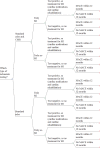Cardiovascular magnetic resonance in emergency patients with multivessel disease or unobstructed coronary arteries: a cost-effectiveness analysis in the UK
- PMID: 31300495
- PMCID: PMC6629389
- DOI: 10.1136/bmjopen-2018-025700
Cardiovascular magnetic resonance in emergency patients with multivessel disease or unobstructed coronary arteries: a cost-effectiveness analysis in the UK
Abstract
Objective: To identify the key drivers of cost-effectiveness for cardiovascular magnetic resonance (CMR) when patients activate the primary percutaneous coronary intervention (PPCI) pathway.
Design: Economic decision models for two patient subgroups populated from secondary sources, each with a 1 year time horizon from the perspective of the National Health Service (NHS) and personal social services in the UK.
Setting: Usual care (with or without CMR) in the NHS.
Participants: Patients who activated the PPCI pathway, and for Model 1: underwent an emergency coronary angiogram and PPCI, and were found to have multivessel coronary artery disease. For Model 2: underwent an emergency coronary angiogram and were found to have unobstructed coronary arteries.
Interventions: Model 1 (multivessel disease) compared two different ischaemia testing methods, CMR or fractional flow reserve (FFR), versus stress echocardiography. Model 2 (unobstructed arteries) compared CMR with standard echocardiography versus standard echocardiography alone.
Main outcome measures: Key drivers of cost-effectiveness for CMR, incremental costs and quality-adjusted life years (QALYs) and incremental cost-effectiveness ratios.
Results: In both models, the incremental costs and QALYs between CMR (or FFR, Model 1) versus no CMR (stress echocardiography, Model 1 and standard echocardiography, Model 2) were small (CMR: -£64 (95% CI -£232 to £187)/FFR: £360 (95% CI -£116 to £844) and CMR/FFR: 0.0012 QALYs (95% CI -0.0076 to 0.0093)) and (£98 (95% CI -£199 to £488) and 0.0005 QALYs (95% CI -0.0050 to 0.0077)), respectively. The diagnostic accuracy of the tests was the key driver of cost-effectiveness for both patient groups.
Conclusions: If CMR were introduced for all subgroups of patients who activate the PPCI pathway, it is likely that diagnostic accuracy would be a key determinant of its cost-effectiveness. Further research is needed to definitively answer whether revascularisation guided by CMR or FFR leads to different clinical outcomes in acute coronary syndrome patients with multivessel disease.
Keywords: cardiovascular disease; cardiovascular magnetic resonance; cost-utility analysis; diagnostic accuracy; economic evaluation; myocardial infarction.
© Author(s) (or their employer(s)) 2019. Re-use permitted under CC BY. Published by BMJ.
Conflict of interest statement
Competing interests: Chiara Bucciarelli-Ducci has received personal fees from Circle Cardiovascular Imaging. Barnaby C Reeves reports former membership of the Health Technology Assessment Commissioning Board (up to 31 March 2016) and Health Technology Assessment Efficient Study Designs Board (October 2014 to December 2014). He also reports current membership of the Health Technology Assessment IP Methods Group and Systematic Reviews Programme Advisory Group (Systematic Reviews NIHR Cochrane Incentive Awards and Systematic Review Advisory Group). Beyond this, all authors have no competing interests, except support from the NIHR grant as detailed in the funding statement.
Figures



References
-
- Cardarelli F, Bellasi A, Ou FS, et al. . Combined impact of age and estimated glomerular filtration rate on in-hospital mortality after percutaneous coronary intervention for acute myocardial infarction (from the American College of Cardiology National Cardiovascular Data Registry). Am J Cardiol 2009;103:766–71. 10.1016/j.amjcard.2008.11.033 - DOI - PubMed
Publication types
MeSH terms
Grants and funding
LinkOut - more resources
Full Text Sources
Medical
